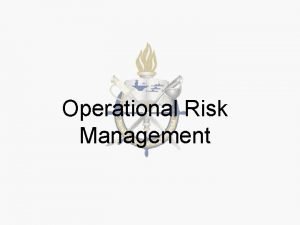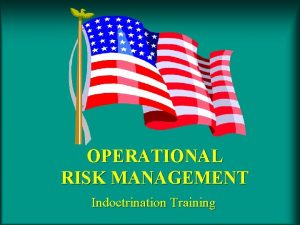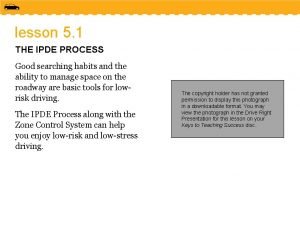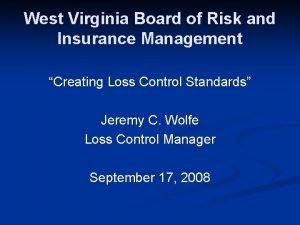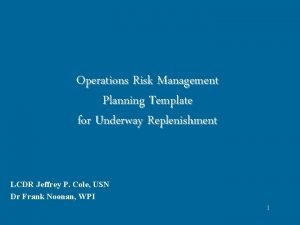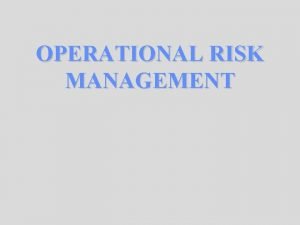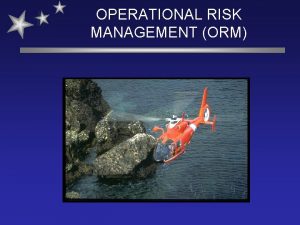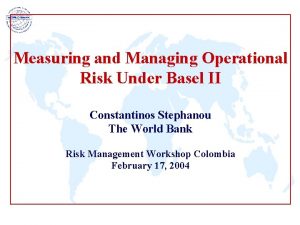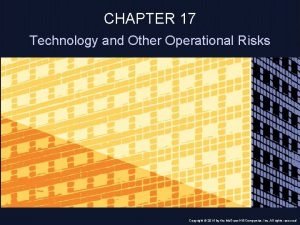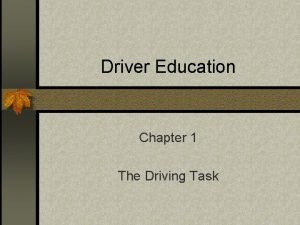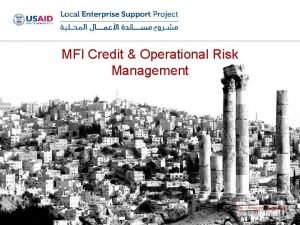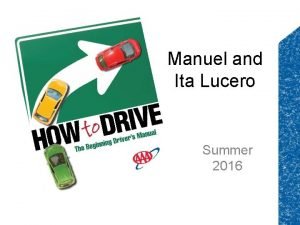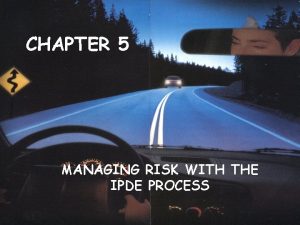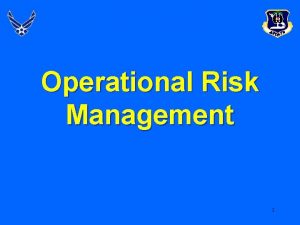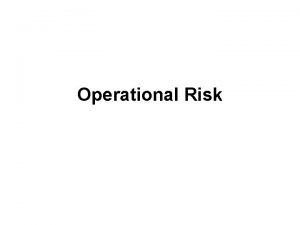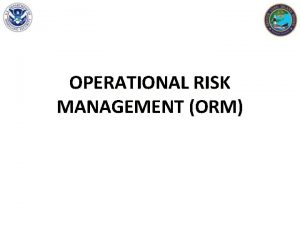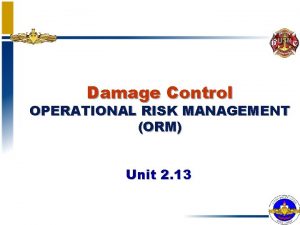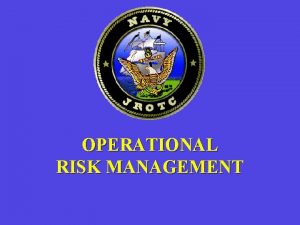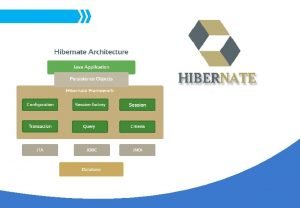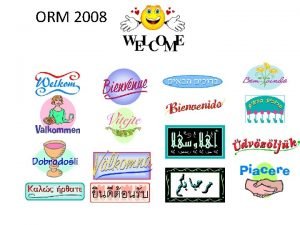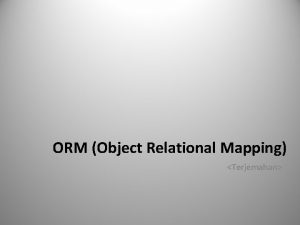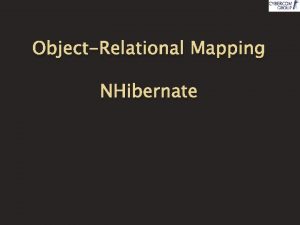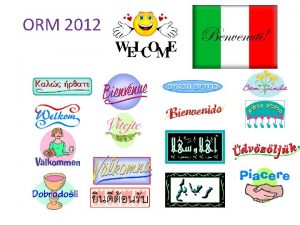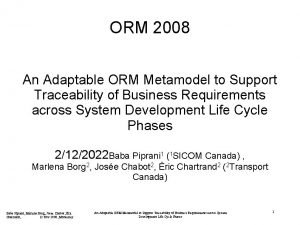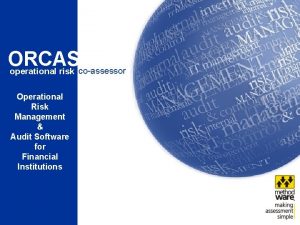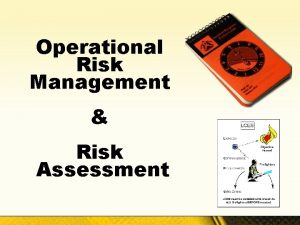Operational Risk Management ORM and the Driving Task






















- Slides: 22

Operational Risk Management (ORM) and the Driving Task 1

Why ORM? 1999 • Estimated 6, 289, 000 police reported traffic crashes. • 41, 345 people killed. • 3, 200, 000 people injured. • Risk of crash involvement among drivers 16 -19 years old is 4 times the risk among older drivers. Sailors and Marines were among those casualties! 2

ORM TERMS Ù Hazard - A condition with the potential to cause illness, injury, death, property damage, or mission degradation. Ù Cause – Something that produces and effect, result, or consequence (i. e. , the person, event or condition responsible for an action or result). HAZARDS CAUSES Operating Equipment Operator Error - Mechanical Failure Weather LTA Clothing - Limited Visibility Change New hazards & reduced effectiveness of controls 3

ORM TERMS Ù Risk - An expression of possible loss in terms of severity and probability. Ù Risk Assessment - The process of detecting hazards and assessing associated risks. 4

ORM FIVE-STEP PROCESS • STEP #1: Identify Hazards • List major steps in your operation/task. • Legs of your driving trip, etc. • Conduct a preliminary hazard analysis. • List hazards associated with each step/leg of your trip. • List the possible causes of the hazards. 5

ORM FIVE-STEP PROCESS • STEP #2: Assess Hazards Determine degree of risk for each hazard. • Review Categories • Risk Assessment Codes • 1 = Critical • 2 = Serious • 3 = Moderate • 4 = Minor • 5 = Negligible • CAT I = Death, loss of asset • CAT II = Severe, injury • CAT III = Minor, injury • CAT IV = Minimal, injury MISHAP PROBABILITY RAC MATRIX HAZARD SEVERITY LIKELY PROBABLY MAY UNLIKELY CRITICAL 1 1 2 3 SERIOUS 1 2 3 4 MODERATE 2 3 4 5 MINOR 3 4 5 5 RISK ASSESSMENT CODE (RAC) 1 -Critical 2 -Serious 3 -Moderate 4 -Minor 5 -Negligible 6

ORM FIVE-STEP PROCESS • STEP #3: Make Risk Decisions • Develop controls for each hazard. • Reduce until benefit>risk. • Develop controls for most serious hazard first. • Assess each hazard again with controls in place. • Is the task worth the risk? 7

ORM FIVE-STEP PROCESS • STEP #4: Implement Controls • Incorporate your controls. • Communicate selected controls to the lowest level. 8

ORM FIVE-STEP PROCESS • STEP #5: Supervise • Enforce your standards and controls. • Remain alert for changes and unexpected developments. • Take corrective action if needed. 9

ORM QUESTIONS 10

ORM Principles ´ Accept risk when benefits outweigh the cost. ´ Accept no unnecessary risk. ´ Anticipate and manage risk by planning. ´ Make risk decisions at the right level. 11

ORM AND SAFE DRIVING ORM is a proven and successful tool for operational use, but it has equal application to many types of activities where there is risk associated. A good example is driver safety. Photo 12

WHY ORM WHEN DRIVING? • Average of 114 persons die each day in motor vehicle crashes – one every 13 minutes. • Vehicle occupants accounted for 85. 3% of traffic fatalities in 1998; remaining 14. 7% were pedestrians, pedal cyclists, and other non-occupants. • The Naval Safety Center asserts that driver safety is our #1 readiness issue. Sailors and Marines were among those casualties! 13

DRIVER SCENARIO • Your unit has been working extremely hard. • CO is granting a 3 -day weekend. • You plan a trip. Perception: Driving is not a high risk activity. Reality: Driving is a high risk activity. 14

STEP #1 – IDENTIFY HAZARDS • Outline the steps in your trip. • List hazards. • What could go wrong during the trip? • What causes things to go wrong? 15

STEP #1 – IDENTIFY HAZARDS • What could go wrong during the trip? Ø Ø Ø Ø FATIGUE VEHICLE BREAKDOWN DRUNK DRIVERS SPEEDING DIRECTIONALLY CHALLENGED ROAD CONSTRUCTION WEATHER & OTHER CONDITIONS • How can I prevent or diminish the associated risks? 16

STEP #2 – ASSESS HAZARDS MISHAP PROBABILITY RAC MATRIX HAZARD SEVERITY LIKELY PROBABLY MAY UNLIKELY CRITICAL 1 1 2 3 SERIOUS 1 2 3 4 MODERATE 2 3 4 5 MINOR 3 4 5 5 RISK ASSESSMENT CODE (RAC) 1 -Critical 2 -Serious 3 -Moderate 4 -Minor 5 -Negligible FATIGUE – 1/1 VEHICLE BREAKDOWN – 3/5 WEATHER & OTHER CONDITIONS – 1/1 DRUNK DRIVERS – 1/2 SPEEDING – 1/3 DIRECTIONALLY CHALLENGED – 3/5 ROAD CONSTRUCTION – 3/4 DIRECTIONALLY CHALLENGED – 3/5 WEATHER & OTHER CONDITIONS – 1/1 VEHICLE BREAKDOWN – 3/5 17

STEP #3 – MAKE RISK DECISIONS FOUR MAJOR AREAS: 1. 2. 3. 4. REVISE? DEVELOP CONTROLS. REASSESS HAZARDS FOR RESIDUAL RISK. DOES THE TASK BENEFIT OUTWEIGH THE RISK INVOLVED? SHOULD YOU CANCEL, POSTPONE, OR 18

STEP #4 – IMPLEMENT CONTROLS • MORAL COURAGE • JUDGMENT • COMMUNICATION SKILLS 19

STEP #5 - SUPERVISE ü Enforce standards and controls. ü Remain alert for changes. ü Take corrective action when and where necessary. 20

REVIEW Principles Accept risk when benefits outweigh the cost. Values Accountable for actions. . . Be there for your shipmates… Accept no unnecessary risk. ‘Work smart’ avoid shortcuts/steps that may cause injury or damage… Minimize risk taking … Anticipate and manage risk by planning. Plan ahead. . . Take time to plan… Ask yourself the right questions. . . Make risk decisions at the right level. Honor Support the chain of command. . . Know that you have choices… Do the right thing. . . right… Courage Commitment 21

SUMMARY 22
 Tcrm navy
Tcrm navy Risk vs hazard orm
Risk vs hazard orm Market risk credit risk operational risk
Market risk credit risk operational risk What are the three steps of the zone control system?
What are the three steps of the zone control system? Operational risk management worksheet
Operational risk management worksheet West virginia board of risk insurance management
West virginia board of risk insurance management Operational risk management plan template
Operational risk management plan template Operational risk management worksheet
Operational risk management worksheet Benefits of operational risk management
Benefits of operational risk management Uscg orm
Uscg orm Basel ii event types
Basel ii event types Technology and operational risk
Technology and operational risk The driving task includes:
The driving task includes: Key risk indicators financial risk management
Key risk indicators financial risk management Risk map
Risk map Sources of operational risk
Sources of operational risk Operational risk scenario
Operational risk scenario Tiered task bias task
Tiered task bias task Chapter 1 managing risk when driving
Chapter 1 managing risk when driving Chapter 4 managing risk with the ipde process answer key
Chapter 4 managing risk with the ipde process answer key Residual risk and secondary risk pmp
Residual risk and secondary risk pmp Business risk and financial risk leverage
Business risk and financial risk leverage Relative risk and attributable risk
Relative risk and attributable risk
